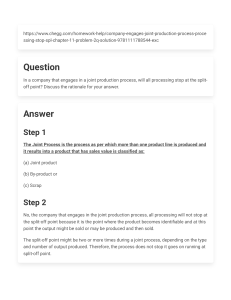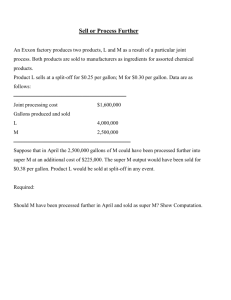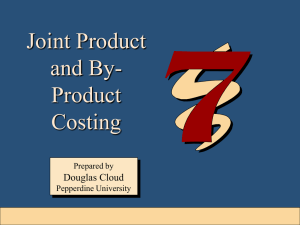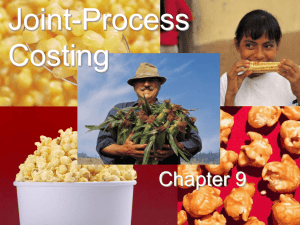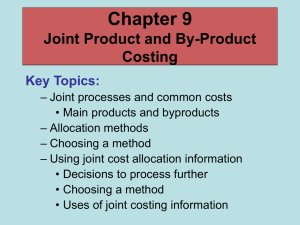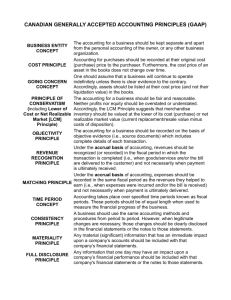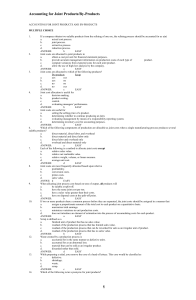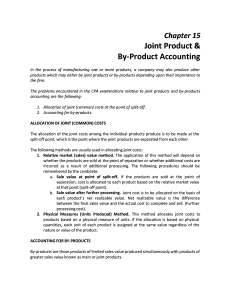COSTING JOINT PRODUCTS
advertisement
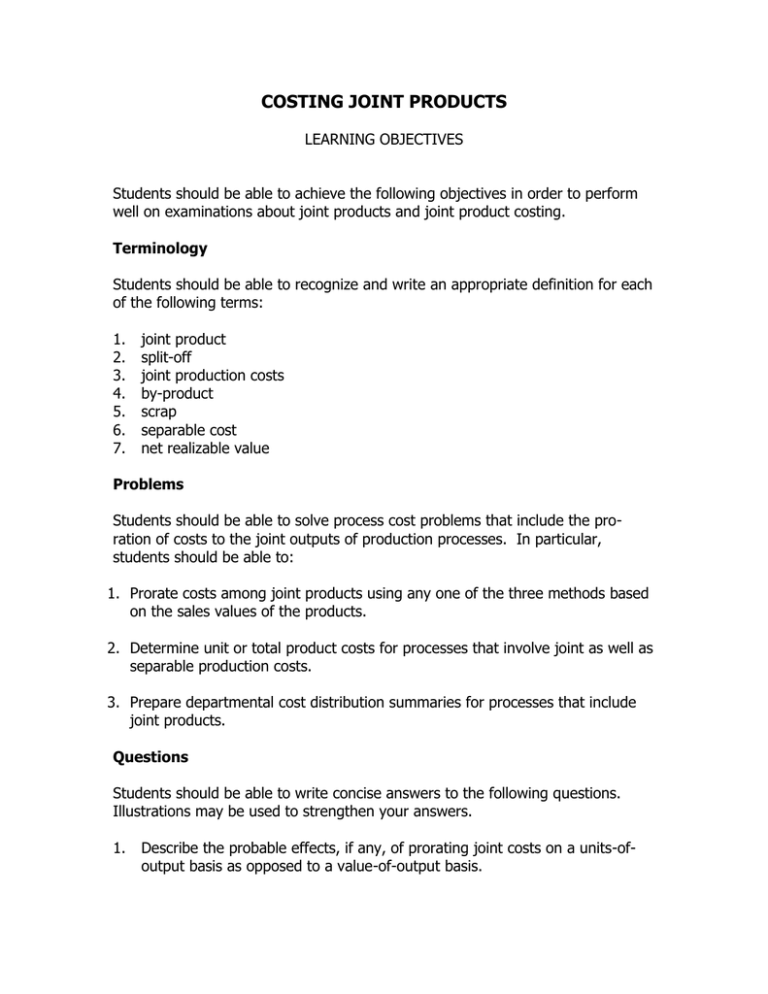
COSTING JOINT PRODUCTS LEARNING OBJECTIVES Students should be able to achieve the following objectives in order to perform well on examinations about joint products and joint product costing. Terminology Students should be able to recognize and write an appropriate definition for each of the following terms: 1. 2. 3. 4. 5. 6. 7. joint product split-off joint production costs by-product scrap separable cost net realizable value Problems Students should be able to solve process cost problems that include the proration of costs to the joint outputs of production processes. In particular, students should be able to: 1. Prorate costs among joint products using any one of the three methods based on the sales values of the products. 2. Determine unit or total product costs for processes that involve joint as well as separable production costs. 3. Prepare departmental cost distribution summaries for processes that include joint products. Questions Students should be able to write concise answers to the following questions. Illustrations may be used to strengthen your answers. 1. Describe the probable effects, if any, of prorating joint costs on a units-ofoutput basis as opposed to a value-of-output basis. 2. Argue against the following proposition: Because it is necessary to know the values of products at split-off (in order to make decisions about product mix), it follows that the value-at-split-off method of prorating joint costs is the most useful. 3. Which method of prorating joint costs results in the most accurate product cost information. Provide arguments in support of the method selected. 4. Is a by-product any difference than a joint product? If so, how do they differ? If not, why do we account for them differently? Joint Products and Joint Costs I. Objectives of Costing Joint Products A. The primary purpose of costing joint products is to charge some portion of production cost to inventories in order to determine accounting income in compliance with generally accepted accounting principles. This is an example of the matching principle that pervades current accounting practice and influences reporting methods . B. A secondary purpose of costing joint products is to report profits by product or by product line in order to satisfy external reporting requirements. The value of such information is very limited because of the arbitrary methods that must be used to assign joint costs to joint products. C. The pro-ration of joint costs is not useful for decision making purposes, so providing information for decision making purposes is not a purpose served by joint cost pro-ration techniques. II. Terminology A. Joint products: When two or more products are produced concurrently as a result of interrelated production activities, the products are said to be joint products if no one of the products can be produced without also creating the other products in the joint group. It may be possible to vary somewhat the relative proportions of the joint products, but all products are presumed to appear. B. Split-off: The stage in the production process at which joint products become identified as distinct products which can be sold or processed further is called the split-off point. C. Joint production costs, or joint costs, are those production costs that are incurred in the production activities which precede the split-off point of a set of joint products. D. By-products: The term by-product refers to a joint product of minor value relative to the value of the other joint products in the set. Byproducts usually require some additional processing beyond the split-off point. E. Scrap: The term scrap is not restricted to the customary concept of a joint product since it includes any waste that has a sales value. Scrap does not usually involve further production or distribution costs. III. Methods of Prorating Joint costs to Joint Products A. Some texts use weight and other measures of production volume to prorate joint costs, but these methods are potentially misleading because some products may show a loss while others show a profit. B. The more acceptable methods of prorating joint costs are based on the relative values of the joint products. 1. In the relative-sales-value at the split-off point method, the joint costs are assigned to individual products in proportion to the sales value of each product relative to the sales value of all products at the split-off point. This method is used without regard to the planned method of disposition of the products. 2. The imputed-sales-value at split-off can be used instead of the actual sales value when the latter information is not available. Also called the net realizable value method, this approach involves determining the net realizable value of the joint products as of the split-off point, where net realizable value is the final sale price (actual or projected) less all costs to complete the product in its final form. Some accountants prefer this approach because it incorporates more information into the determination of the relative value of the products at the split-off point. 3. The uniform gross margin method incorporates information about costs after the split-off point. After it has been decided which products are to be sold at split-off and which products are to be processed further, then the joint costs can be allocated in the following manner. The over-all gross profit percentage is used to (1) determine the gross profit for each product, (2) deduct the gross profit from sales value to find the total cost, and (3) reduce total cost by each product’s further processing costs to find the joint cost shares for each product. IV. By-products are joint-products of minor value. Because of their minor value, these products may be accounted for in a variety of ways. A. Revenue Methods: 1. Report by-product or scrap revenue along with other operating revenue without attempting to explicitly match costs with these revenues. 2. Report by-product or scrap revenue as a source of “miscellaneous income,” without attempting to explicitly match costs with these revenues. 3. Report by-product or scrap revenue as a deduction from cost of goods sold without attempting to explicitly match costs with these revenues. 4. Report by-product or scrap revenue as a deduction from the cost of production without attempting to explicitly match costs with these revenues. 5. Report the net-realizable by-product or scrap revenue as a deduction from the cost of goods sold. a. The net realizable value may be sales price less selling costs and separable production costs beyond the split-off point. b. The net realizable value may be sales price less (1) a normal profit margin, (2) selling costs, and (3) separable production costs. B. Cost Methods: Report the net realizable by-product or scrap revenue as a deduction in determining net production cost. 1. The net realizable value may be sales price less selling costs and separable production costs beyond the split-off point. 2. The net realizable value may be sales price less a. a normal profit margin b. selling costs, and c. separable production costs. V. Decision-making: A. Unconstrained: If there are no production or marketing constraints, then additional processing of a joint product beyond the split-off point is desirable if the incremental revenues exceed the incremental costs. B. Constraints: If either production or marketing constraints exist, then one must use a decision model that reflects opportunity costs, as well as incremental costs and revenues, in order to decide whether or not the additional processing is profitable. VI. Preferred Treatment: The preferred method of accounting for inventories of joint products may well be net realizable value. The net realizable value, not the prorated joint cost, is of interest for decision-making purposes. Therefore, the net realizable value of the joint products is of some relevance, where the prorated joint production cost is not useful for decision making purposes. The net realizable value less an average or normal profit margin is essentially equivalent to the uniform gross margin method.
